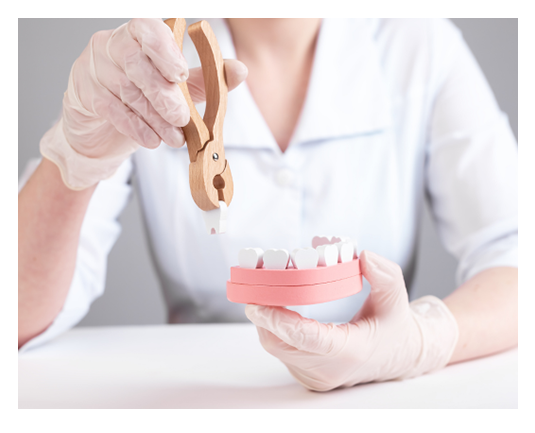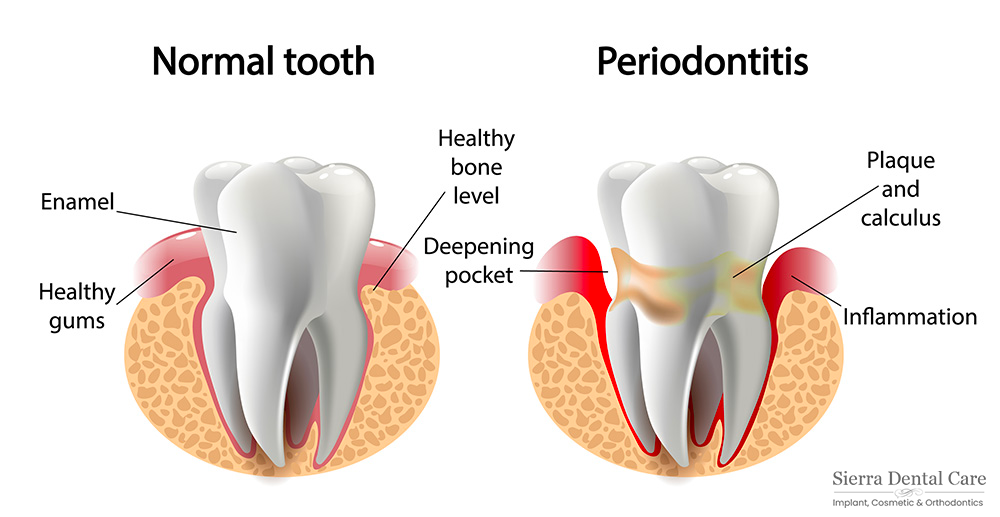PERIODONTAL DISEASE

Periodontal Disease
At Sierra Dental, we offer a broad range of treatments designed to treat the different stages of gum disease: Gingivitis and periodontal disease. When someone has gingivitis, they are in the early stages of the disease and typically just need a professional cleaning and better oral hygiene at home. If left untreated, gingivitis can quickly lead to periodontal disease. Periodontal disease is usually painless and can lead to dental infection and even tooth loss.
What Is Gum Disease?
Gum disease is an infection of the soft tissues surrounding the teeth. It is caused by plaque, a thin film of bacteria left behind while eating and drinking. These bacteria can linger between the teeth and in the pockets of the gums, eventually creating an infection that will not go away. The initial symptoms of gum disease include bleeding or swollen gums, bad breath and a dull ache in the gums.
Periodontal disease is an advanced stage of gum disease. Patients with periodontal disease sometimes don't know they have it until it is too late. Some of the signs and symptoms of periodontal disease are bad breath, swollen gums, loose teeth, and gum loss leading to spaces between the teeth. If detected early, periodontal disease can be treated with non-surgical techniques to remove the source of the gum infection and prevent further gum and bone loss. Routine dental exams and cleanings are the key to preventing periodontal disease.
How to prevent gum disease:
- Brush your teeth twice a day, especially at bedtime.
- Replace your toothbrush every 6 months or sooner if the bristles are frayed.
- Floss once a day. Decay–causing bacteria still linger between teeth where toothbrush bristles can’t reach. Flossing at night helps remove plaque and food particles between the teeth and the gum line.
- Regular dental cleanings are important to maintain proper oral health, so don’t skip your teeth cleaning appointment!

Periodontal Disease
The periodontics refers to the dental specialty that pertains to the prevention, diagnosis and treatment of periodontal disease that affects the gums and jawbone. The gum tissues serve to surround and support the teeth and the underlying jawbone anchors teeth firmly in place. Periodontists have completed several years of extra dental training and are concerned with maintaining the function, health and aesthetics of the jawbone and tissues.
Periodontal disease generally begins when the bacteria living in plaque cause an infection in the surrounding tissues of the teeth, causing them to become irritated and painful. Eventually, this infection will cause the jawbone to recede and the tooth to become loose.
Reasons for periodontal treatment
Periodontal disease is a progressive condition which begins with mild gum inflammation called gingivitis. It is the leading cause of tooth loss in adults living in the developed world, and should be taken very seriously. Periodontal disease (often called gum disease) is typically signified by red, swollen, painful, or bleeding gums, but in some cases has no noticeable symptoms. Periodontal disease generally begins when the bacteria living in plaque cause an infection in the surrounding tissues of the teeth, causing them to become irritated and painful. Eventually, this infection will cause the jawbone to recede and the tooth to become loose.
Gum disease or periodontal disease occurs when exposed to harmful bacteria, tartar, and plaque along the gumline for an extended period. When the infection along the gum line affects the outermost gum layer - gingival tissue, it is diagnosed as Gingivitis. If Gingivitis, the earliest stage of periodontal disease, is left untreated can lead to tooth loss and bone loss. As the infection digs deeper, the condition turns serious. The symptoms of periodontal disease are signified by swollen, painful, or bleeding gums. In some cases, the symptoms remain unnoticeable.
Gingivitis vs Periodontitis - What is the Difference?
There are several reasons why periodontal treatment may be necessary:
- Moderate/advanced gum disease – This occurs when the gums are bleeding, swollen or red around most teeth and the jawbone has begun to recede.
- Localized gum recession – The infection which propagates moderate or advanced gum disease often begins in one area. Gum recession may also be caused due to over brushing with a hard bristle brush, or due to a tooth that is not positioned properly. Immediate treatment is required to prevent further spreading.
- Before crown lengthening – The periodontist may lengthen the crown of the tooth by removing surrounding soft tissue to provide more tooth exposure.
- Ridge augmentation – This procedure, often called “recontouring” may be required to correct an uneven gum line. Before embarking on treatment, a periodontist needs to treat any bacterial infections and periodontitis.

Don't hesitate to call for a complimentary consultation.
